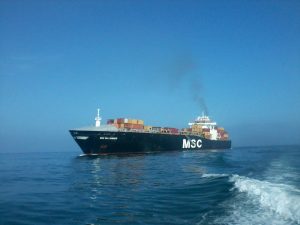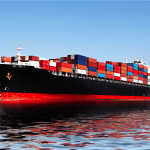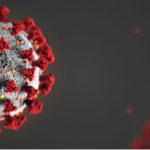Coronavirus & IMO 2020 Good News, Bad News
 2020’s international shipping news cycle so far has been an exercise in good news, bad news.
2020’s international shipping news cycle so far has been an exercise in good news, bad news.
To get at what I’m talking about, let me introduce you to a fun book by Jeff Mack I read sometimes with my kids (yes, it’s a children’s book) called Good News, Bad News. The book just plays with an old writing device of alternating good and bad news. Good news — rabbit and mouse (I told you it’s a children’s book) are going on a picnic; bad news — it starts to rain. Of course, the events get more severe as the book goes along, like the bunny and mouse run into a cave to escape one danger only to find a bear inside the cave. If you want a more grown up example of this classic device, think about the greatest Christmas movie of all time: Die Hard.  Bad news — the roof John McClane (Bruce Willis) is on is about to explode. Good news — he ties himself to a fire hose and jumps to avoid being incinerated. Bad news — John is hanging on the side of a skyscraper. Good news — he busts through a window and gets inside. Bad news — the big, metal hose reel falls and the fire hose still tied to John starts pulling him out the window. You get the idea…
Bad news — the roof John McClane (Bruce Willis) is on is about to explode. Good news — he ties himself to a fire hose and jumps to avoid being incinerated. Bad news — John is hanging on the side of a skyscraper. Good news — he busts through a window and gets inside. Bad news — the big, metal hose reel falls and the fire hose still tied to John starts pulling him out the window. You get the idea…
As this year started, all the international shipping worry was about how the transition to IMO 2020 would go. Carriers having to change ship fuel to much cleaner and more expensive fuel or retrofit ships with scrubber systems to meet the International Maritime Organization’s 0.5% carbon emission mandate was likely to cause disruptions and big cost increases for shippers. That was the bad news. But the new year brought good news — the launch of IMO 2020 was going pretty smoothly.
Then came some bad news. Controversies over low sulfur fuel charges and scrubbers were rising. Good news — fuel prices were looking more manageable than expected (in fact, now there have been big drops in low sulfur fuel prices). Bad news — a novel coronavirus broke out in China.
There was a shred of good news for the shipping industry with the initial outbreak of COVID-19, the name now given to the novel coronavirus. This terrible outbreak was happening during the Chinese New Year or Spring Harvest Festival, which is a time when China shuts down manufacturing anyway, meaning a viral outbreak hitting the country — terrible as that is — would at least have a much smaller economic impact on the world than it would normally have. Bad news. The outbreak was a full epidemic, extending the Chinese New Year shutdowns and significantly impacting shipping.
Good news — President Trump, despite being called xenophobic for doing it in the moment, immediately put a travel ban on China, preventing the virus from quickly spreading to America. Bad news — other countries did not, and the disease quickly hit Iran, Italy, Japan, and South Korea. Those last two are especially big trade partners when the supply chain out of China is disrupted.
Good news came again as Universal Cargo heard from our sources like Seamaster that production was ramping back up in China after all the extended shutdowns from the coronavirus. Mike Wackett & Gavin van Marle even report in a Loadstar article:
… shipping activity in China appears to be picking up, according to new data from liner consultancy SeaIntelligence.
It says there is now a clear reduction in the number of announced blank sailings by carriers as trucking operations resume in China, leading to increased export cargo arriving at ports and ships are needed to handle the backlog of containers.
Of course, the bad news to go with the good news of China getting back in operation is that the coronavirus has officially hit pandemic levels according to the World Health Organization (WHO). European countries of Spain, France, and Germany are seeing cases spread fast, and the coronavirus is now hitting communities in the U.S.
Yesterday, President Trump announced a travel ban on Europe to the U.S. So despite China getting manufacturing and shipping back going, the spread of the coronavirus through other nations likely means more, probably much more, shipping disruption.

Photo of MSC Mia by Farid mernissi
But then we also see a piece of good news. The build up of empty shipping containers that has been causing shippers to get hit with detention fees for something out of their control is about to go away. The world’s biggest container ship is headed to the Ports of Los Angeles and Long Beach to clear that bad news backlog of empty shipping containers that piled up because of all the blank sailings that happened with China’s coronavirus shutdown. A Splash247 article by Sam Chambers gives all the details on that.
The repositioning of shipping containers will rebalance global supplies to get shipping ready to go, but the pandemic threatens to halt shipping anyway and mess up that rebalance before it’s actually gained. According to a Shipping Watch article by Tomas Kristiansen, the “new coronavirus wave could hit the container sector like the financial crisis.” That would be seriously bad news.
At least, there are a couple last pieces of good news shippers can cling to though. One can be found in the president’s address (above) to the nation. The president is issuing financial relief to businesses and individuals impacted by the virus.
The other piece of good news is the encouragement to take from China’s recovery from the epidemic within a couple months. That’s not to say coronavirus is all done in China; however, as stated above, the nation is getting back to normal in terms of production and shipping. When there’s the bad news of today’s (Thursday, March 12th) update on Worldometer’s coronavirus page of 272 new cases in the U.S., 595 in France, 779 in Germany, 782 in Spain, 1,075 in Iran, and 2,651 in Italy, China being down to just 18 new cases very good news. That’s much better than the hundreds of new cases per day China was seeing for a while. That should give optimism to other countries, especially the U.S., as they fight the coronavirus.




